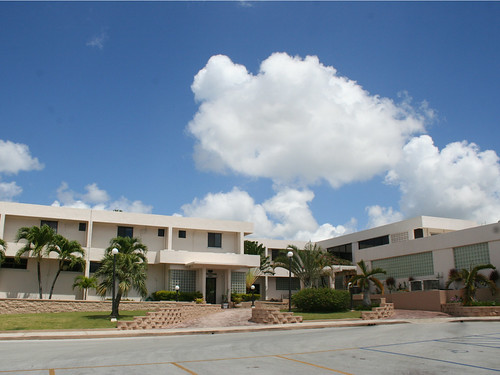History in Guam
The first Jehovah’s Witnesses in Guam arrived from the Philippines in the 1940s. These first Witnesses were contract workers assigned to assist with post-World War II reconstruction. While in Guam, they organized the first Micronesian congregation in 1951, as well as introduced the teachings of the Bible to fellow worker Tony Salcedo. Salcedo, a Filipino and former boxer, helped establish a foundation for future Witnesses on the island. Unlike his colleagues, Salcedo was able to remain on the island even after their construction company folded because he had married a Chamorro. In the mid-1950s, Salcedo was hosting meetings at his home and spending weekends preaching throughout the island.
By 1954, the first missionaries assigned to Guam had arrived. They were Sam and Virginia Wiger, and their congregation had grown to warrant a larger meeting place. The Wigers consequently set up the first Kingdom Hall in a vacated military mess hall. Merle Lowmaster succeeded the Wigers, and he became the first missionary to spread the message of Jehovah’s Witnesses in Saipan, Chuuk, Pohnpei, Belau and Yap.
In 1964, a visit to Guam by the president of the Watch Tower Society, N.H. Knorr, proved critical to the growth of Jehovah’s Witnesses in the region. Knorr assigned six missionaries throughout Micronesia and increased their travels throughout the area. More growth would later follow after a visit from Nathaniel Miller of Hawai’i. Miller toured Guam and Micronesia and made several recommendations, including increasing the number of missionaries in Guam to four and creating a missionary home in the southern part of the island.
In 1969, Guam and Micronesia became part of the Hawai’i branch. Later, the Guam Branch Committee would be established, with Miller named as coordinator. Arthur White took over the coordinator position in 1987, and under his term, the Guam branch expanded to include a total of four Kingdom Halls, and additional office and factory space. Currently, the Guam Branch Committee consists of four members – Arthur White, Salvador Soriano, Roger Konno and Barak Bowman.
Today, the Watch Tower’s Guam Branch office in Barrigada continues to serve as the center for Jehovah’s Witnesses on the island. To keep pace with Guam’s diverse population, missionaries speak several languages including Japanese, Chuukese, Tagalog, Iloko, Korean and Chinese. The Guam branch also serves the greater Micronesia area as the Barrigada facility prints bible study materials in 11 languages for distribution throughout the region.
Beliefs and history
Jehovah’s Witnesses are Christians who believe in the Bible as the word of God. Followers take their name from Jehovah, or God and Creator, and they help spread what they refer to as “the good news” of Jehovah’s Kingdom.
Jehovah’s Witnesses believe the earth will remain forever, and that people –both living and dead – can share in the eternal earthly blessings of God’s Kingdom if they live according to Jehovah’s purpose.
Jehovah’s Witnesses began in the 1870s in Allegheny, Pennsylvania, as a small bible study group. Charles Taze Russell led the group’s growth, and in 1879, the first magazine, Zion’s Watch Tower and Herald of Christ’s Presence was published. In 1881, Zion’s Watch Tower Tract Society was formed. The name eventually changed to Watch Tower Bible and Tract Society and began with fifty Witnesses going house to house in an effort to propagate the faith.
The society called themselves Jehovah’s Witnesses beginning in 1931 to distinguish themselves from other Christians. Today, there are more than 90,000 congregations worldwide in more than 230 nations. The administrative authority that oversees Witnesses worldwide is called the Governing Body and is located in the international headquarters of Brooklyn, New York.
Jehovah’s Witnesses share Jesus’s good news by visiting homes several times a year. Witnesses discuss current events, share scripture and arrange for home bible study at no cost. Jehovah’s Witnesses also come together regularly at gathering places called Kingdom Halls to listen to public lectures on and to study the Bible.
Observances
Jehovah’s Witnesses observe the Memorial of Christ’s death each year. This date varies annually according to the Christian calendar. On this occasion, Jehovah’s Witnesses partake of the symbolic bread and wine as commanded by Jesus.
For further reading
1997 Yearbook of Jehovah’s Witnesses. New York: Watchtower Bible and Tract Society, 1997.
Jehovah’s Witnesses. “Jehovah’s Witnesses—Official Website: jw.org.”


